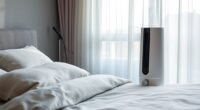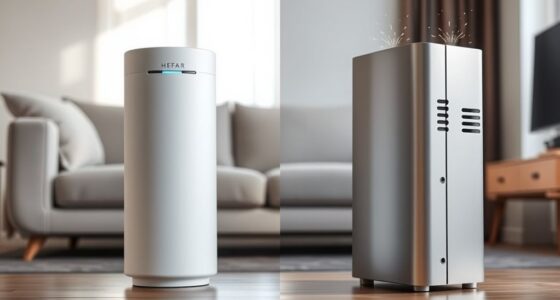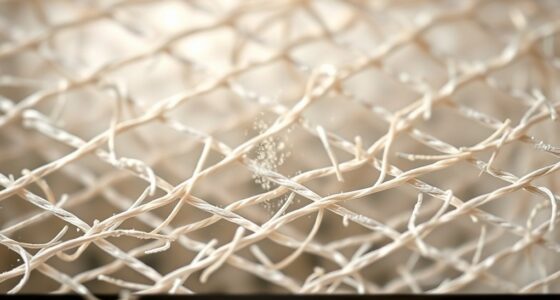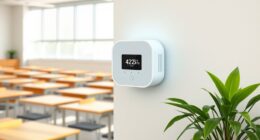Owning an air purifier involves balancing initial costs, ongoing expenses like filter replacements and energy use, and environmental benefits. Efficient models may cost more upfront but save money long-term through lower energy bills and fewer filter changes. Choosing the right filters and maintaining your device properly can boost performance and reduce costs. To maximize savings and guarantee healthy air quality, understanding these factors can guide your purchase and upkeep decisions. Keep exploring to learn how to optimize your investment.
Key Takeaways
- Investing in energy-efficient air purifiers reduces monthly operating costs and environmental impact over the device’s lifespan.
- Higher-quality filters like HEPA last longer and may lower replacement frequency, saving money long-term.
- Initial purchase price should be balanced with ongoing costs such as energy use and filter replacements for total ownership value.
- Proper maintenance and timely filter changes maintain efficiency, extend device lifespan, and optimize cost savings.
- Government incentives and eco-friendly features can further decrease ownership expenses and support sustainable choices.
Understanding the Cost of Air Purifier Units
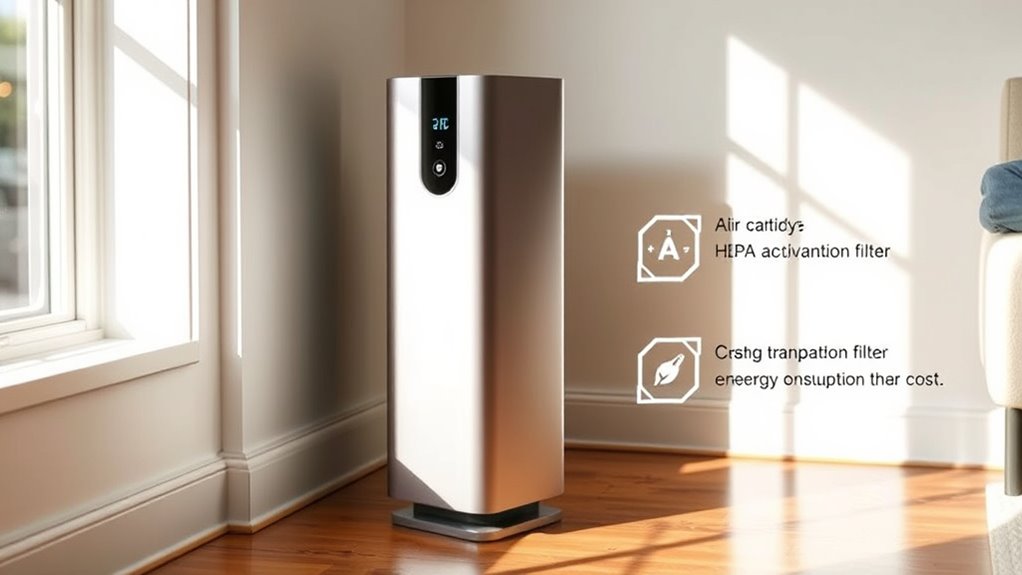
Understanding the cost of air purifier units is essential for making informed purchasing decisions. High-quality air purifiers can *substantially* improve your air quality, but their prices vary based on features and brand reputation. You’ll find that reputable brands often offer more reliable performance and durability, which can justify higher upfront costs. Cheaper units might save you money initially but could compromise air quality or require more frequent replacements. Consider the initial purchase price alongside the long-term value—such as filter replacements and maintenance. A well-known brand with a strong reputation for quality ensures you get a device that effectively cleans your air while lasting longer. Balancing cost with brand trust helps you choose an air purifier that meets your needs without sacrificing effectiveness. Additionally, understanding filter replacement schedules can help you assess the ongoing costs associated with ownership.
How Energy Consumption Impacts Your Electricity Bill
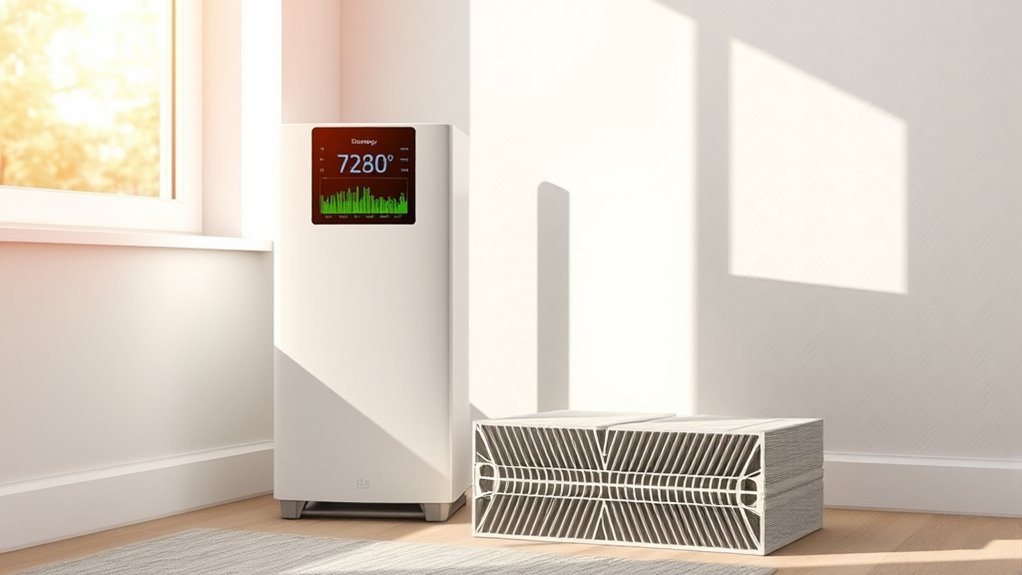
While the upfront cost of an air purifier matters, how much it consumes electricity can substantially affect your ongoing expenses. Energy-efficient models help you meet air quality standards without inflating your electricity bill. To understand the impact, consider the table below:
| Model Type | Average Power Use | Estimated Monthly Cost |
|---|---|---|
| Standard Purifier | 50W | $10 |
| Energy-Saving | 30W | $6 |
| High-Performance | 70W | $14 |
| Government Incentives | Varies | Possible rebates |
Energy consumption varies with model type, influencing your costs. Additionally, government incentives can offset purchase or operational expenses, making efficient models more attractive. Lower energy use not only saves money but also helps you adhere to air quality standards more sustainably. Energy efficiency plays a crucial role in reducing long-term operational costs and environmental impact.
Evaluating Filter Types and Replacement Expenses

When choosing an air purifier, you need to consider filter material costs and how often you’ll need to replace them. Some filters last longer and cost more upfront, while others are cheaper but require frequent changes. Understanding these differences helps you estimate the long-term expenses and make smarter purchasing decisions. Additionally, weighing the longevity of filters can help you determine the overall value of your investment.
Filter Material Costs
The choice of filter material considerably impacts both the performance and ongoing costs of air purifiers. Different materials, such as HEPA, activated carbon, or electrostatic filters, have varying filter material costs and durability. HEPA filters are highly effective but often come with higher prices, though they tend to last longer with proper maintenance. Activated carbon filters are cheaper initially but may need more frequent replacements due to lower filter durability, especially when filtering strong odors or chemicals. Your selection influences your long-term expenses, as more durable filters reduce replacement frequency and costs. Understanding the trade-offs between upfront filter material costs and filter durability helps you make smarter purchasing decisions, ensuring both clean air and economical ownership over time. Incorporating AI-powered maintenance can also help optimize filter replacement schedules and reduce unnecessary costs.
Replacement Frequency Variations
Have you ever wondered how often you’ll need to replace your air purifier’s filter? The answer depends on the filter type and your usage habits. Some filters, like HEPA filters, typically have a longer filter lifespan of about 6 to 12 months, while carbon filters may need replacement every 3 to 6 months. Replacement intervals vary based on air quality, room size, and whether you have pets or smokers in the home. If you ignore recommended schedules, you risk reduced efficiency and increased energy consumption. Keep an eye on your filter’s condition and follow manufacturer guidelines to maintain ideal performance. Understanding these replacement frequency variations helps you plan expenses and avoid unnecessary costs, ensuring your air purifier continues to provide clean air effectively. Regular maintenance and timely replacements are also crucial for filter efficiency and longevity.
Long-term Expense Impacts
Choosing the right air purifier involves considering long-term costs, especially related to filter replacement expenses. Different filter types vary in longevity and cost, impacting your overall expenses over time. Higher-quality filters often meet stricter air quality standards and last longer, reducing replacement frequency. Technological advancements have led to more efficient filters that can better capture pollutants while needing less frequent replacement, saving you money. It’s essential to evaluate both initial costs and ongoing expenses tied to filter maintenance. While some filters may seem affordable upfront, their frequent replacements can add up quickly. Investing in a model with durable filters aligned with current air quality standards can deliver better value and cleaner air over the long term. Moreover, understanding the role of attention in creative practice can help consumers stay focused on making informed, sustainable choices that support long-term savings and health.
The Role of Maintenance in Total Ownership Costs
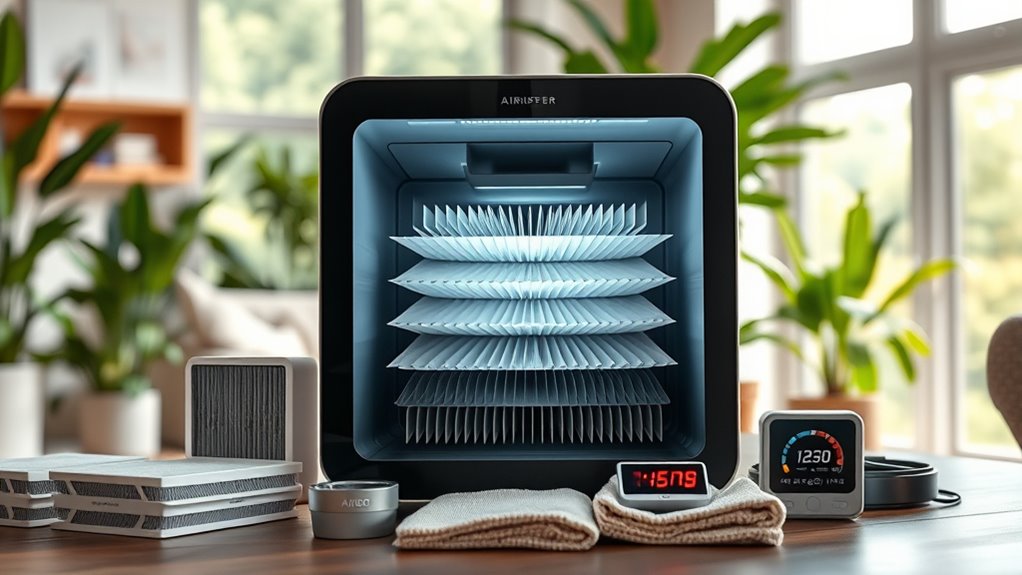
Regular filter replacements and maintaining energy efficiency can substantially affect your total ownership costs. If you ignore filter replacement frequency, you may face higher expenses from reduced air purifier performance, while increased energy use can inflate your bills. Staying on top of maintenance helps keep costs predictable and your device working at its best. Additionally, choosing models with auto functions that adjust fan speed based on air quality can further optimize energy consumption and reduce ongoing expenses.
Filter Replacement Frequency
Since filter replacement is a key part of maintaining air purifier performance, understanding how often you need to change filters can substantially impact your total ownership costs. The filter lifespan varies depending on the type of filter and usage, typically ranging from three to twelve months. Knowing the recommended replacement cycles helps you avoid over- or under-maintenance, which can lead to decreased efficiency or increased expenses. Regularly replacing filters ensures ideal air quality and maintains the device’s effectiveness. Keep an eye on manufacturer guidelines for your specific model, as neglecting proper replacement schedules can cause filters to clog faster or degrade prematurely. Proper maintenance, including filter replacement, is essential for maximizing the efficiency and longevity of your air purifier. By staying consistent with filter changes, you can extend the life of your air purifier and prevent unnecessary costs down the line.
Energy Consumption Impact
Maintaining your air purifier by replacing filters as recommended not only keeps the device running efficiently but also influences its energy consumption. When filters are clean and properly fitted, the purifier works more effectively, improving air quality without overexerting its motor. Dirty or clogged filters force the fan to work harder, increasing energy use and noise levels, which can make the device noisier and less efficient. Proper maintenance ensures ideal airflow, reducing strain on the motor and lowering energy costs. Additionally, well-maintained purifiers operate quietly, enhancing your comfort without sacrificing performance. Regular upkeep, including filter replacement, helps balance air quality improvements with energy efficiency, saving you money over time while maintaining a quieter, more effective air purification system. Mazda Tuning techniques can be applied to optimize your device’s performance and longevity.
Comparing Different Models for Cost-Effectiveness

When comparing different air purifier models for cost-effectiveness, understanding that it is crucial to look beyond the initial purchase price and consider long-term expenses like energy consumption, filter replacements, and maintenance. You should evaluate how each model impacts air quality, ensuring it effectively cleans the space without excessive costs. You might also want to consider remote work benefits, such as creating a healthier environment that can boost productivity and well-being during long hours at home. Your user preferences also matter—some models offer quieter operation or specific features that suit your lifestyle. While a cheaper unit might seem appealing upfront, it could cost more over time due to higher energy use or frequent filter changes. Balancing upfront costs with ongoing expenses helps you choose a model that fits your budget and air quality needs. Ultimately, the most cost-effective model aligns with your priorities, offering good performance at reasonable long-term costs.
Calculating Long-Term Savings With Energy-Efficient Devices

Have you ever considered how much energy your air purifier uses over time? By choosing energy-efficient models, you can save money and improve indoor air quality. These devices often meet or exceed air quality standards, effectively reducing indoor pollutants without excessive power consumption. Vetted options are tested for reliability and performance, ensuring you get the most value from your investment. To calculate your long-term savings, start by noting your purifier’s wattage and average daily use. Multiply this by your local energy rate to find daily costs, then multiply by the number of days you use it annually. Upgrading to an energy-efficient model may have a higher upfront cost but results in lower electricity bills over time. Plus, maintaining it properly guarantees consistent performance, helping you stay within air quality standards while minimizing energy expenses.
The Environmental Impact and Its Economic Implications
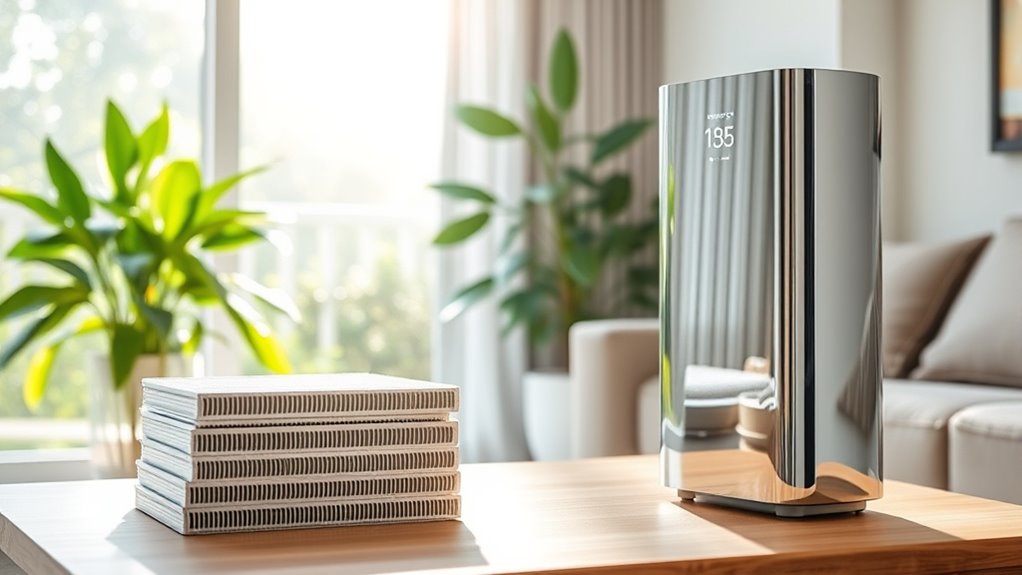
The environmental impact of air purifiers extends beyond cleaner indoor air, influencing broader ecological and economic systems. Your choice of device affects your carbon footprint, especially if it consumes significant energy or uses non-sustainable filters. While air purifiers can improve health, they also contribute to energy demand, which is impacted by environmental regulations aimed at reducing emissions. Stricter regulations may push manufacturers to develop more eco-friendly models, encouraging innovation and possibly higher upfront costs but lower long-term environmental harm. By choosing energy-efficient purifiers and sustainable filters, you help reduce their ecological footprint. Energy-efficient devices not only benefit the environment but can also lead to economic savings over time, aligning your health goals with broader sustainability efforts.
Tips to Maximize Savings and Minimize Expenses

To save money on air purifiers, focus on optimizing filter maintenance so you replace filters only when necessary. Choosing energy-efficient models can also substantially cut your electricity bills over time. Implementing these tips helps you get the most value without sacrificing air quality. Additionally, selecting high-quality filters can improve filtration efficiency and extend the lifespan of your device.
Optimize Filter Maintenance
Wondering how to get the most out of your air purifier filters? The key is proper maintenance scheduling to extend their lifespan. Regularly check and clean or replace filters as recommended by the manufacturer. This prevents dirt buildup that can reduce efficiency and force your purifier to work harder, increasing energy costs. Keep an eye on filter indicators or set reminders for maintenance intervals. Well-maintained filters maintain ideal airflow, lowering energy consumption and saving you money. Avoid neglecting filter upkeep, which can lead to premature replacements and higher expenses. By sticking to a consistent maintenance routine, you ensure your air purifier runs efficiently longer, maximizing the benefits while minimizing ongoing costs. Proper filter care is a simple, effective way to maximize savings. Additionally, monitoring air quality indicators can help determine the optimal times for filter replacement, ensuring your device operates at peak efficiency.
Choose Energy-Efficient Models
Choosing energy-efficient air purifiers can substantially lower your long-term costs, especially if you prioritize models with high energy ratings. These models consume less power while maintaining ideal air quality, helping you save on electricity bills. Look for devices with energy star certification, which indicates efficiency. Additionally, select purifiers that support moisture control features, as proper humidity levels can improve air quality and reduce mold growth. Efficient models often come with smart settings, allowing you to run them only when needed, further cutting costs. By choosing the right energy-efficient air purifier, you maximize savings while ensuring your indoor environment remains healthy and comfortable. Incorporating high refresh rates in your device can also improve performance and longevity, further enhancing your investment. This approach makes your investment more sustainable and effective over time.
When to Replace Filters for Optimal Performance and Savings

Knowing when to replace your air purifier filters is essential for maintaining ideal performance and saving money. A filter’s lifespan varies depending on usage and air quality, but typically, you should replace it when:
- The filter appears visibly dirty or clogged, reducing airflow.
- You notice a decline in air quality or fresh scent.
- Your manufacturer recommends replacement after a specific period, often every 6-12 months.
- Waterpark amenities can sometimes contribute to increased airborne contaminants, making timely filter replacements even more important.
Ignoring these signs can increase energy costs, as the purifier works harder, and lead to higher replacement costs if the filter becomes damaged. Regularly monitoring filter condition helps you avoid unnecessary expenses and ensures your device operates efficiently. Staying on top of replacements balances ideal performance with cost savings, prolonging your air purifier’s lifespan and effectiveness.
Making an Informed Purchase Decision Based on Total Costs

When evaluating air purifiers, focusing solely on the initial purchase price can be misleading. To make an informed decision, consider the total costs over the unit’s lifespan, including energy consumption, filter replacements, and maintenance. A cheaper model might have higher running costs due to inefficient filters or high energy use, which can negate initial savings. Think about how the purifier will impact indoor pollution and air quality over time. Investing in a slightly more expensive model with lower energy use and longer-lasting filters can save you money and improve air quality in the long run. Additionally, understanding the cycle of breakups and relationship patterns can help you evaluate the long-term reliability and performance of different models. Balancing purchase price with ongoing costs ensures you get the best value and effectively reduce indoor pollution. This approach helps you make smarter, cost-effective choices for cleaner air.
Frequently Asked Questions
How Do Air Purifier Warranties Affect Long-Term Ownership Costs?
Warranty coverage directly impacts your long-term ownership costs by reducing potential repair expenses. When your air purifier has a solid warranty, you’re protected from unexpected repair costs, making it more affordable over time. Without a good warranty, repair costs can add up quickly, increasing your overall expenses. So, choosing a model with extensive warranty coverage can save you money and provide peace of mind during your ownership.
Are There Financial Incentives or Rebates for Energy-Efficient Models?
You might think saving money on air purifiers is impossible, but many rebate programs and tax incentives make it easier than ever. If you choose energy-efficient models, you could qualify for significant financial perks that cut costs dramatically. These incentives can feel like hitting the jackpot, helping you invest in cleaner air without breaking the bank. Check local programs and government offers—they’re designed to reward your commitment to sustainability and savings.
How Does Indoor Air Quality Impact Health-Related Costs?
Indoor pollution can greatly affect your health, leading to increased health expenses over time. Poor air quality may cause respiratory issues, allergies, and other health problems, which can result in higher medical bills and missed work. By improving indoor air quality with an air purifier, you reduce exposure to harmful pollutants, potentially lowering your health-related costs and enhancing your overall well-being. Investing in good air quality benefits your health and finances.
What Is the Resale Value of High-End Air Purifiers?
You might wonder about the resale value of high-end air purifiers. In the resale market, these units often experience market depreciation, meaning their value drops over time. Factors like brand reputation, condition, and features influence how much you can recover. While high-end models tend to retain more value than budget options, expect depreciation to reduce their resale price, so consider this when investing in premium air purifiers.
Do Smart Features Increase Overall Ownership Expenses?
Smart features can increase your ownership expenses because they often require additional maintenance, app subscriptions, and potential repairs. While these features add convenience and advanced control, they also mean you’ll spend more on electricity, updates, or troubleshooting. However, if you use smart features wisely, they can help optimize your air purifier’s efficiency, potentially offsetting some costs. Overall, smart features tend to raise your ownership expenses slightly, but provide added value and control.
Conclusion
Did you know that a high-quality air purifier can save you up to 30% on energy costs over its lifetime? By understanding the true costs—energy, filters, maintenance—you can make smarter choices. Regularly replacing filters at the right time not only keeps your air clean but also prevents unnecessary expenses. With careful planning, you’ll maximize savings while enjoying cleaner, healthier air without breaking the bank.

